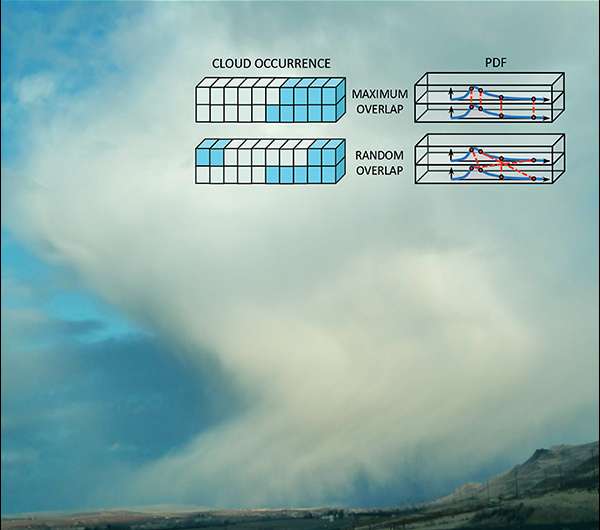Researchers improve modeling of cloud vertical structure

A famous song-writer looked at clouds from both sides, but it's still difficult for climate and weather models to get a good grasp on them. Now, researchers at Pacific Northwest National Laboratory have improved a statistical representation of clouds in a climate model to capture clouds from all sides and in-between.
Their technique predicts how well cloud properties line up vertically: are clouds at one level aligned with clouds at other levels, or are they randomly distributed? And, it reveals how these vertical relationships depend on the type of cloud particles: droplets, rain, snow, or hail. With this information, scientists can better describe cloud types and their characteristics in a model that has previously ignored such details.
The PNNL team, along with collaborators from the University of Wisconsin-Madison and the National Center for Atmospheric Research, found that including the falling speed of these cloud components, along with the already-included dependency on the cloud's turbulence strength, will improve climate models' clouds.
Joni Mitchell's song is right. Clouds block the sun...and rain and snow on everyone. But that's not all. Clouds soak up heat, moisture, particles in the atmosphere, reflect and scatter the sun's energy, and cool and shade the Earth. That's why it's so important to get clouds "right," even though they are the hardest climate feature to capture in a computational model. They are constantly changing and vary in size, type, density, and other characteristics. Clouds' vertical structure, important for precipitation formation and transfer of solar and thermal radiation (think heat) in the atmosphere, is not currently resolved in coarse-resolution global models. Consequently, statistical treatments of the cloud vertical distributions, such as those presented and tested in this study, are vital for improving climate model performance.
Coarse-resolution climate models increasingly rely on statistical representations of cloud distributions to represent an unresolved horizontal variability of clouds and precipitation. But a cloud overlap assumption also is required to draw representative vertical profiles from these distributions.
Using high-performance computers at the Department of Energy's National Energy Research Scientific Computing Center (NERSC), the team conducted detailed numerical simulations, which explicitly represented the 3D structure of cloud and precipitation fields. They analyzed these virtual clouds for statistical relationships among cloud and precipitation variables at different levels.
The team found that faster falling raindrops and graupel particles (soft hail) exhibit significantly higher coherence in their vertical distributions than slow-falling cloud droplets and ice crystals. The study suggests that to improve the representation of cloud overlap, the correlations between cloud particles at different levels need to depend on the hydrometeor (type of water particle) properties, such as fall speeds, in addition to the currently implemented dependency on the convection strength.
The researchers are now working on quantifying the dependency of cloud overlap on particle fall speeds and on implementing this dependency in a parameterization for global climate models.
More information: Mikhail Ovchinnikov et al. Vertical overlap of probability density functions of cloud and precipitation hydrometeors, Journal of Geophysical Research: Atmospheres (2016). DOI: 10.1002/2016JD025158
Journal information: Journal of Geophysical Research , Journal of Geophysical Research - Atmospheres
Provided by Pacific Northwest National Laboratory




















